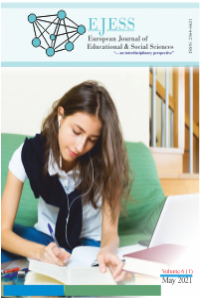Leadership of special students in strengthening their ability by understanding their weaknesses
Leadership of special students in strengthening their ability by understanding their weaknesses
This paper explores the traits of the leadership dexterity of special students. Leadership in special students is not an expected phenomenon. Cases of special students studying at the University of Tampere, Finland are reported on here. Each case contributes uniqueness and offers qualitative insight into this phenomenon. Interviews were conducted on the respondent’s willingness. The interviewees were special students who suffered from different special dexterities such as cerebral palsy, dyslexia, and height phobia. The findings suggest that realizing weakness is important and transforming these in strengths that lead to behavioral changes. Initiating special abilities enhances in strengthening the weaknesses empowering them to perform better through adaptability. Their initiative persistence is high because they are pushing themselves harder. This empowers them to increase their competence through maintaining the stability and adaptability to perform. However, losing persistence is another form of weaknesses.
Keywords:
Leadership dexterity, special students, leadership potentialities, special ability, initiative persistence adaptations,
___
- Bajraszewski, E.; Carne, R.; Kennedy, R.; Lanigan, A.; Ong, K.; Randall, M.; Reddihough, D. & Touzel, B. (2008). Cerebral Palsy: An information guide for parents. 2 – 3.
- Bass, B. M & Stogdill, R. M. (1990). Handbook of leadership: Theory, research and managerial applications (3rd ed.). New York: The free press.
- Bass, B. M. (2008). The Bass handbook of leadership: Theory, research and managerial applications (4th ed.). New York: The free press.
- Burns, J. (1978). Leadership. New York: Harper & Row. Derue, D. S, Nahrang, J, Wellman, N & Humphrey, S. E. (2011). Trait and behavioral theories of leadership: An integration and meta-analytic test of their relative validity. Personnel Psychology, 64(1), 7 – 8. doi: 10.1111/j.1744-6570.2010.01201.x
- Hammond, J. & Hercule, F. (2000). Understanding Dyslexia: An introduction for dyslexic students in higher education. Glasgow School of Art: Glasgow.
- Illeris, K. (2007). What do we actually mean by experiential learning? Human Resources Development Review, 6 (1), 84—95. doi: 10.1177/1534484306296828.
- Krigger, K. W. (2006). Cerebral Palsy: An Overview. American Family Physician, 71 (1), 91 – 92.
- LeBeau, R. T.; Glenn, D.; Liao, B.; Wittchen, H.; Baum, K.; Ollendick, T. & Craske, M. G. (2010). Specific Phobia: A review of DSM-IV specific phobia and preliminary recommendations for DSM-V. Depression and Anxiety; 27:148 - 167. doi: 10.1002/da.20655.
- Northouse, P. G. (2010). Leadership theory and practice (5th ed). Sage publication. Thousand Oak: California.
- Official Statistics of Finland (OSF). (2013). Special education [e-publication]. ISSN=1799-1617.. Helsinki: Statistics Finland. Retrieved from http://www.stat.fi/til/erop/2013/erop_2013_2014-06-12_tie_001_en.html
- Rajbhandari, M. M. S. & Rajbhandari, S. (2015). Leadership maintenance: Filling the gap for leadership competences. Educational Research and Reviews, 10 (21), 2777 – 2788. doi: 10.5897/ERR2015.2336.
- Rajbhandari, M. M. S. (2011). My Lifelong Learning Realm: An auto-ethnography experiential Learning in Finland [A research report]. University of Tampere, School of Education. Tampere, Finland.
- Rajbhandari, M. M. S. (2011). Strengthening the strength of public private partnership model in education: A case study of Durbar High School in Nepal. Retrieved from http://files.eric.ed.gov/fulltext/ED516967.pdf
- Rajbhandari, M. M. S. (2016). Why do educational Leaders need maintenance? International Journal of Educational Sciences, 12 (1), 1 – 6.
- Rajbhandari, M. M. S. ; Basaran, K. ; Hujala, E. & Kinos, J. (2011). Theoractive Learning. How theory and Practice meet. Perception of students at the University of Tampere, Finland. ED545537. Retrieved from http://files.eric.ed.gov/fulltext/ED545537.pdf
- Stogdill, R. M. 1974. Handbook of Leadership (1st ed.); New York: The free press.
- Trajkovski, S. (2015). Ability of self-advocacy of people with intellectual disabilities. Journal of Special Education and Rehabilitation; 16 (1-2), 134 – 136.
- Yayın Aralığı: Yılda 2 Sayı
- Başlangıç: 2016
- Yayıncı: Ali KORKUT
Sayıdaki Diğer Makaleler
Social media marketing tools among Polish public higher education institutions
Daniel BİCZYSKO, Marta R. JABŁOŃSKA
Evaluation of effectiveness of an enriched curriculum prepared using Geogebra software
Öğretmenlerin Kürtçe öğretimine yönelik algılarının incelenmesi
Leadership of special students in strengthening their ability by understanding their weaknesses
Reflective and reflexive beliefs of two pre-service secondary Mathematics teachers
